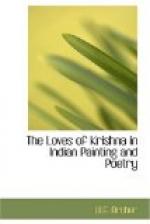A poem celebrating one of the main modes of Indian music is here represented by Radha and Krishna seated on a swing. The mode itself is called ‘the swinging music’ but since swinging was symbolical of love-making and also took place during the rains, the season of longing, its spirit was sometimes impersonated not by an ordinary prince but by Krishna himself. In the picture, peacocks, which were common symbols for the lover, are shown against a storm-tossed sky—the battered clouds and writhing lightning being symbolic references to ‘the strife of love.’ At the foot, lotus plants, their flowers symbolizing the male, their leaves the female, rise from a rain-filled river.
The picture represents one of the more poetic traditions of Indian painting but at a comparatively late stage of its development. During the sixteenth century the Malwa style had played a decisive part in the evolution of Rajput painting, but by the eighteenth century had shed something of its early ardour.
[Illustration]
PLATE 34
Krishna attended by Ladies
Illustration to the musical mode, Bhairava Raga
Hyderabad. Deccan, c. 1750
Victoria and Albert Museum, London
Like Plate 33, an illustration to a poem accompanying a leading mode of Indian music. Krishna is sitting on a bed while Radha is rubbing his right arm with sandal preparatory to making love. In the foreground a maid is grinding the sandalwood into a paste. Although the poem itself contains no mention of Krishna, it speaks of Bhairava—a form of Siva—as a raging lover, ‘insensate in a whirlwind of desire.’ On this account Krishna—identified by his blue skin—has been inserted in the picture, his character as a lover according with the frenzied character of the poem. In the background a bullock is lifting water from a well and a gardener is bending over a bed of poppies. Ducks and fishes sport in the water.
Illustrations to modes of music were common features of the Muslim art of the Deccan—the association of certain modes with Krishna being carefully preserved. One of the finest series of raga and ragini pictures executed at Hyderabad and now in the India Office Library, London, contains exquisite versions with Krishna themes.
[Illustration]
PLATE 35
Radha disguised as a Constable arresting Krishna as a Thief
Garhwal, Punjab Hills, c. 1785
Indian Museum, Calcutta
Tired of Krishna’s attempts to waylay the cowgirls, Radha dons a turban, brandishes a constable’s heavy staff and seizes Krishna by the wrist. ’I am a policeman of Raja Kansa, come to take you to gaol,’ she says. The picture shows the cowgirls standing with their pitchers of curd, while cowherd boys—Krishna’s accomplices—take to their heels. Krishna himself stands limply by, as if uncertain who the constable is.




